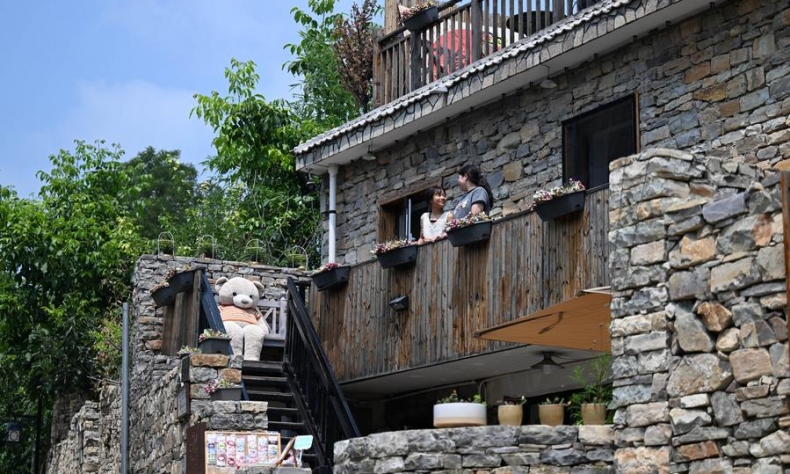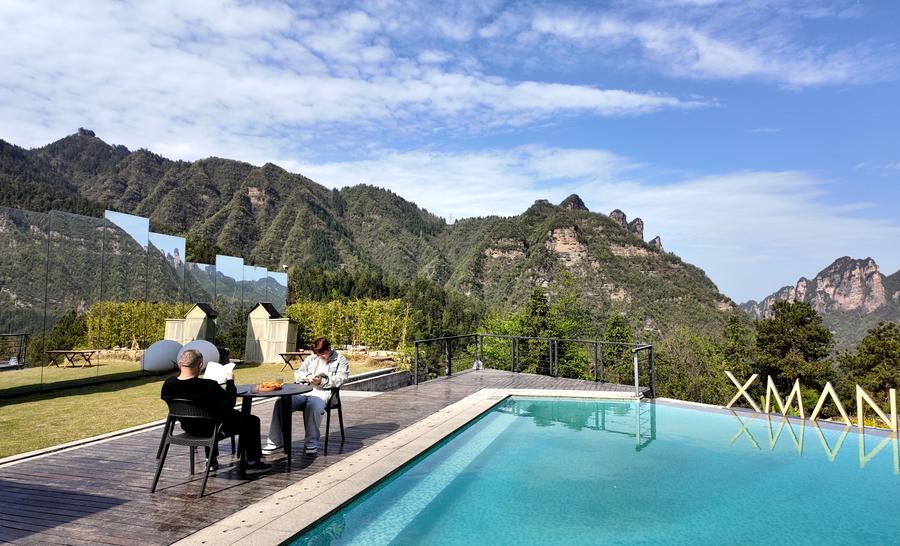Rural Homestays Are Redefining the Tourism Economy

The success of homestays has become a catalyst for local specialty industries and rural revitalization in many regions.
Huzhou, a small city in Zhejiang Province, saw a surge in bookings for its boutique homestays in May. There, guests immersed themselves in the mountain retreats, picking tea leaves and river rafting by day, then gathering around firepits for tea and open-air cinema under the stars at night.
Traditionally, travelers tend to stay in hotels close to famous tourist spots and spent their days ticking off must-see attractions. But in recent years, a new trend of opting for rural homestays has emerged, as more young travelers prioritize immersive experiences and off-the-beaten-path destinations over checklist tourism. This homestay economy has now become a powerful new engine driving the growth of the tourism economy.
“I came across so many posts about Huzhou’s homestays on social media platforms such as lifestyle and e-commerce app RedNote, but last weekend one caption really struck me: ‘My weekend deserves to be wasted in a place like this—listening to the rain and birdsong, and gazing at the bamboo forests outside of the window’,” 28-year-old Tianjin resident Chen Tianyu, who had booked a three-day stay at Moganshan, a mountain retreat in Huzhou, told Beijing Review. “As a tea lover, I am especially drawn to the tea-picking activities many homestays offer. It’s such a refreshing experience.”
“Throughout my past business trips and longer vacations, I’ve mostly stayed at chain hotels—they’re clean, convenient and reasonably priced with good locations. But sometimes, you can’t help feeling they lack character, local culture and that interactive atmosphere among guests,” Chen added. “Many of my friends who prefer homestays argue these smaller lodgings outperform big hotel brands in exactly these areas. So I’d like to give it a go.”
Distinctive services
Typical homestays are small-scale, non-standardized lodgings that usually operate in rural or culturally distinct areas. Unlike branded chain hotels, which prioritize uniformity, efficiency and corporate branding, homestays emphasize unique architecture, strong regional features, owner-host interactions and immersive experiences.
These unique advantages are turning homestays into a rising trend. According to leading online booking platform Trip.com’s 2024 Rural Tourism Revitalization White Paper, both the supply of and demand for rural homestays saw steady growth in 2024, with year-on-year increases of 19.6 percent and 24.3 percent, respectively.

Official data from the Huzhou Culture, Sports and Tourism Bureau showed that during the May Day holiday this year (from May 1 to 5), Deqing County, one of the key homestay clusters in Huzhou, received 1.98 million tourist visits, registering a 43-percent year-on-year increase. Tourism revenue reached 2.73 billion yuan ($380 million), up 44.7 percent from 2024. The average occupancy rate for homestays in Deqing hit 81.7 percent, generating approximately 59.2 million yuan ($8.2 million) in revenue.
“The core competitiveness of homestays lies in their non-standardized services and the unique culture shaped by their hosts,” Zhang Xiaojun, President of the Homestay Inn and Boutique Hotel Branch of the China Tourism Association, said at the 2024 China Homestay Industry Summit. “To differentiate from traditional hotels, the future of homestays should focus on ‘micro-vacation’ offerings—like weekend wellness retreats.”
“The ‘non-standardized services’ offered by homestays go beyond architectural uniqueness. Instead, service is embodied in the personalized activities they host, such as hiking along customized routes or sharing family recipes. Such heartfelt services are irreplaceable by brand hotels,” Zhang noted. The activities offered by many homestays in Huzhou, such as bamboo forest yoga and tea picking, are perfectly integrated with local resources, he added.
Homestays across China are leveraging their unique locations and local cultures to curate immersive experiences, including intangible cultural heritage workshops, travel photography, flower admiring, horse riding, fishing and camping. Culture and sports aside, many homestays have also embraced niche themes—from vinyl record collections and ikebana flower arrangements to vintage aesthetics and DIY aromatherapy, catering to travelers seeking distinctive experiences.
“Many young travelers visiting Dali are drawn to photoshoots and activities in ethnic minority villages. Therefore, I’ve partnered with locals to give my guests access to the village bonfire parties of the Bai ethnic group. I also designed photo-worthy spots in the yard, allowing them to take impressive pictures,” Zhu Jingyu, a homestay owner in Dali, a city in Yunnan Province, told Beijing Review. “These photos and videos go viral on social media, and they’ve really boosted our repeat guest rate.”
“Social media content marketing has become the primary customer acquisition channel for homestays. In 2023, orders for homestay experience packages featuring short video displays on Trip.com saw a 30-percent increase in both conversion and repeat booking rates,” Wu Shan, Director of Trip.com’s Rural Revitalization Research Institute, said at a press conference for the earlier-mentioned white paper.
“This means homestay operators should focus on enhancing their video content and scene presentation to create emotional resonance and attract potential guests,” Wu added.

Coordinated development
The success of homestays has become a catalyst for local specialty industries and rural revitalization in many regions.
In Huzhou, the homestay boom has considerably boosted the sales of local white tea products. Citing this an example, Gu Huimin, then Dean of the School of Tourism Sciences at Beijing International Studies University, told monthly magazine Tourism Tribune in a 2023 interview that, “The integration of homestays with local specialty industries evolves through three distinct phases. In the initial stage, homestays simply provide basic lodging services. During the second phase, we can see the introduction of relevant cultural activities such as tea ceremonies and white tea tastings to attract experience-seeking travelers. At the mature stage, homestays begin actively shaping local supply chains, such as by boosting the development of tea packaging design.”
“Homestays and local specialties are mutually reinforcing, while promoting homestays, we need to focus on irreplaceable local experiences like bamboo forest dinners and tea-picking activities; and shareable souvenirs for families and friends, such as tea gift boxes. And promotional activities for homestays will also help with the brand image of tea products,” Qian Jiliang, head of Moganshan’s homestay association, said at a homestay industry conference in 2024.
“Our livestream event, themed homestay plus tea-picking experience, on Douyin (the Chinese version of TikTok) in March 2024 attracted over 5 million views in a single session, driving a direct 60-percent increase in that month’s homestay occupancy rate,” Qian added.
At the 2025 Cherry Festival, which kicked off in Qingdao, Shandong Province, on May 8, homestays teamed up with local farmers to organize cherry-picking activities, driving the sales of local agricultural products.
“Seasonal events like blossom and cherry festivals create crucial windows to promote agricultural products while connecting cultural tourism resources,” Wang Jianlong, Secretary of the Wulongjian Village Branch of the Communist Party of China in Qingdao, told newspaper Qingdao News. “One homestay-owning family now welcomes more than 50 daily visitors to their jointly managed orchard during peak season,” he added, highlighting how integrated agritourism boosts rural incomes.
 Facebook
Facebook
 Twitter
Twitter
 Linkedin
Linkedin
 Google +
Google +










